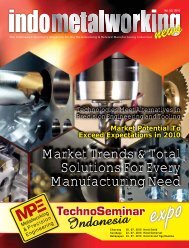High Speed Machining Precision Tooling - Indobiz.biz
High Speed Machining Precision Tooling - Indobiz.biz
High Speed Machining Precision Tooling - Indobiz.biz
Create successful ePaper yourself
Turn your PDF publications into a flip-book with our unique Google optimized e-Paper software.
Automation<br />
This simple loader is designed for casually tended<br />
operation. The track is manually loaded, and load/unload<br />
time is 4.5 seconds<br />
5,000 parts per day, the solution is<br />
a little more complicated. And if, in<br />
addition, there is a family of parts<br />
where the lengths vary from 2 to 24<br />
inches, the complexity jumps another<br />
level. Now consider the automation<br />
if the diameters vary from 0.25 to<br />
1 inch, or if fl ats are milled on each<br />
end that need orientation to one<br />
another. Each variable added to the<br />
product makes your automation<br />
choices more important. There are<br />
trade-offs between price, speed and<br />
convertibility.<br />
As the volume grows and the need for<br />
speed becomes a major factor, the<br />
complexity of the loader grows. An<br />
example is a three-axis, pneumatically<br />
driven, pick-and-place loader, which<br />
is very fast. With the gripper for part<br />
pickup, it is easy to change-over for<br />
different part geometries. However,<br />
the cost of this system is almost<br />
double the simple shuttle type.<br />
The simpler automation devices<br />
are virtually part specifi c. That,<br />
of course, makes them limited in<br />
their fl exibility. Change-over of such<br />
“hard automation” to accommodate<br />
different types of parts will be diffi cult,<br />
if not impossible.<br />
The next step up the automation ladder<br />
is either SCARA or fi ve-axis robots.<br />
The advantage of these loaders is<br />
their speed and fl exibility. They can<br />
pick up parts from pallets, re-orient<br />
them for workholding, remove fi nished<br />
parts and replace them to a pallet or<br />
conveyor.<br />
The initial investment is substantially<br />
higher, almost double the cost of<br />
the three-axis pneumatic pick-andplace<br />
style. However, for the most<br />
possibilities and quickest changeovers<br />
for very disparate parts, they<br />
have their place. The benefi ts of the<br />
multi-axis programmable robots,<br />
when integrated with stacking pallet<br />
systems, can be vast.<br />
Automation systems can be confi gured<br />
so machines can run untended for<br />
hours on end. An example of this is a<br />
robot integrated into a pallet system<br />
that will hold 20 pallets with 30 parts<br />
per pallet. That’s a run of 600 parts<br />
throughout 10 hours at 1 minute per<br />
part. At that point, integration of part<br />
inspection can easily be done. Since<br />
the robot has the part, why not perform<br />
basic inspection? There is very little<br />
lost time and much more confi dence<br />
in your fi nished product.<br />
Analyze Your Automation Needs<br />
In most cases, confi guring an<br />
automation solution is unique to the<br />
application or applications being<br />
looked at. Therefore, when thinking<br />
about automation, there will be<br />
different solutions for each shop.<br />
Here is a checklist to follow:<br />
Flexibility of change-over:<br />
• Lot sizes<br />
• Family variations<br />
Part handling concerns:<br />
• Blank variations<br />
• Workholding issues<br />
• Part cosmetics and fragility<br />
concerns<br />
Throughput requirements:<br />
• Simple manually loaded magazines<br />
• Conveyors<br />
• Pallet systems<br />
• Vibratory bowls<br />
Environment:<br />
• Coolant<br />
• Abrasive chips<br />
Shop capability and skill level:<br />
• Electrical and electronic skills<br />
• PLC and motion control axes<br />
• Tool and die custom machining<br />
After fi guring out which automation<br />
direction to go in, its cost is not always<br />
simple to calculate. The following chart<br />
illustrates how the cost of automation<br />
goes up with its complexity. The<br />
chart below is based on typical costs<br />
associated with automating a small<br />
CNC lathe. Mills, grinders, drills and<br />
any other shop process may be<br />
automated; however, their costs will<br />
be different.<br />
The actual cost of the system will be<br />
affected by its speed (time per part),<br />
cost per change-over, frequency of<br />
change-overs and maintenance and<br />
support.<br />
A Sea Change In<br />
Automation Tools<br />
The biggest change in automation<br />
implementation has been the evolution<br />
of 3D modeling software. A common<br />
misconception by shops of all sizes<br />
is that designing in 3D takes a major<br />
investment in capital and time. It used<br />
to be that delving into the world of<br />
CAD took a fair amount of training and<br />
an extended period of practice before<br />
applying the investment.<br />
Even then, the diffi culty of use<br />
and limited tools hampered its<br />
implementation by operators on the<br />
front line. During the evolution phase<br />
of an automated system, the ability<br />
of the designer to experiment, try<br />
out and research solutions requires<br />
This CAD drawing shows a pallet station fed by a SCARA<br />
robot. The pick and place until loads/unloads the<br />
machine, gages fi nished parts and palletizes them<br />
indometalworking news Vol. 2 / 2008 39




